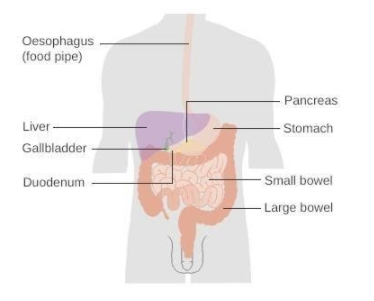
Draw a diagram of the human alimentary canal and label the following.
Oesophagus, gallbladder, liver and pancreas.
Answer
508.5k+ views
Hint: In humans digestive system consists of alimentary canal and associated gland. These glands help in the digestion of food.
Complete answer:
Alimentary canal starts with the mouth and opens outside through anus . The mouth leads to the buccal cavity or oral cavity. The oral cavity has a number of teeth and a muscular tongue.
The tongue is a voluntary muscular and glandular structure which occupies the floor of the mouth . The pharynx leads to oesophagus.

FIGURE SHOWING A WELL LABELLED HUMAN DIGESTIVE SYSTEM
Majority of mammals, including human beings, have two sets of teeth during their life that is one temporary set and one permanent or adult tooth. Such type of dentition is called diphyodont.
Note: Oesophagus- the oesophagus is a thin, long tube which extends posteriorly passing through the neck, thorax and diaphragm and leads to a j- shaped bag like structure called stomach.
Liver- It is the largest gland of the body weighing about 1.2 to 1.5 kg in an adult human. It is situated in the abdominal cavity, just below the diaphragm, it has two lobes that are right and left lobes.
Gall bladder:- It produces and stores bile. Bile is used to convert large globules of fats to small globules of fat. This process is called emulsification.
Pancreas:- Pancreas is a merocrine gland. It releases enzymes such as pepsin that converts protein into amino acids.
Complete answer:
Alimentary canal starts with the mouth and opens outside through anus . The mouth leads to the buccal cavity or oral cavity. The oral cavity has a number of teeth and a muscular tongue.
The tongue is a voluntary muscular and glandular structure which occupies the floor of the mouth . The pharynx leads to oesophagus.

FIGURE SHOWING A WELL LABELLED HUMAN DIGESTIVE SYSTEM
Majority of mammals, including human beings, have two sets of teeth during their life that is one temporary set and one permanent or adult tooth. Such type of dentition is called diphyodont.
Note: Oesophagus- the oesophagus is a thin, long tube which extends posteriorly passing through the neck, thorax and diaphragm and leads to a j- shaped bag like structure called stomach.
Liver- It is the largest gland of the body weighing about 1.2 to 1.5 kg in an adult human. It is situated in the abdominal cavity, just below the diaphragm, it has two lobes that are right and left lobes.
Gall bladder:- It produces and stores bile. Bile is used to convert large globules of fats to small globules of fat. This process is called emulsification.
Pancreas:- Pancreas is a merocrine gland. It releases enzymes such as pepsin that converts protein into amino acids.
Recently Updated Pages
Master Class 11 Business Studies: Engaging Questions & Answers for Success

Master Class 11 Accountancy: Engaging Questions & Answers for Success

Master Class 11 Computer Science: Engaging Questions & Answers for Success

Master Class 11 English: Engaging Questions & Answers for Success

Master Class 11 Social Science: Engaging Questions & Answers for Success

Master Class 11 Economics: Engaging Questions & Answers for Success

Trending doubts
A boat goes 24 km upstream and 28 km downstream in class 10 maths CBSE

Why is there a time difference of about 5 hours between class 10 social science CBSE

The Equation xxx + 2 is Satisfied when x is Equal to Class 10 Maths

What is the full form of POSCO class 10 social science CBSE

Change the following sentences into negative and interrogative class 10 english CBSE

Fill the blanks with proper collective nouns 1 A of class 10 english CBSE




